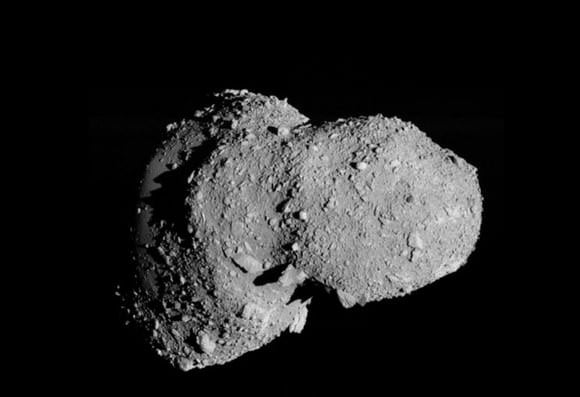[/caption]
We usually think of asteroids as dark, dry, lifeless chunks of rock, just like the image of Asteroid Itokawa, above. But some asteroids may be more like "minor planets" after all. Researchers have found evidence on one asteroid – 24 Themis – of water ice and organic materials. This discovery is exciting on two fronts: one, this evidence supports the idea that asteroids could be responsible for bringing water and organic material to Earth, and two, if the proposed path for NASA is to visit an asteroid, having water and organics at the destination makes things a bit more interesting.
24 Themis, a 200-kilometer wide asteroid sits halfway between Mars and Jupiter. Using NASA's Infrared Telescope Facility on Hawaii's Mauna Kea, Josh Emery from the University of Tennessee, Knoxville and Andrew Rivkin of Johns Hopkins University measured the spectrum of infrared sunlight reflected by the asteroid and found the spectrum consistent with frozen water. They determined that 24 Themis is coated with a thin film of ice. They also detected organic material.
"The organics we detected appear to be complex, long-chained molecules. Raining down on a barren Earth in meteorites, these could have given a big kick-start to the development of life," Emery said.
Finding ice on the surface of 24 Themis was a surprise because its proximity to the sun causes ice to vaporize. Plus, the surface temperatures are too warm for ice to stick around for a long time.
[caption id="attachment_63750" align="aligncenter" width="400" caption="This image shows the Themis Main Belt which sits between Mars and Jupiter. Asteroid 24 Themis, one of the largest Main Belt asteroids, was examined by University of Tennessee scientist, Josh Emery, who found water ice and organic material on the asteroid's surface. His findings were published in the April 2010 issue of Nature. Credit: Josh Emery/University of Tennessee, Knoxville"]
[/caption]
"This implies that ice is quite abundant in the interior of 24 Themis and perhaps many other asteroids," Emery said, and therefore the ice is regularly being replenished.
This might be done by "outgassing" in which ice buried within the asteroid escapes slowly as vapor migrates through cracks to the surface or as vapor escapes quickly and sporadically when 24 Themis is hit by space debris.
The discovery of abundant ice on 24 Themis may mean that water is much more common in the Main Belt of asteroids than previously thought. Since Themis is part of an asteroid "family" that was formed from a large impact and the subsequent fragmentation of a larger body long ago, this scenario means the parent body also had ice and has deep implications for how our solar system formed.
Ice on asteroids may be the answer to the puzzle of where Earth's water came from, Emery said.
"Asteroids have generally been viewed as being very dry. It now appears that when the asteroids and planets were first forming in the very early Solar System, ice extended far into the Main Belt region," Emery said. "Extending this refined view to planetary systems around other stars, the building blocks of life -- water and organics -- may be more common near each star's habitable zone. The coming years will be truly exciting as astronomers search to discover whether these building blocks of life have worked their magic there as well."
In choosing a possible destination for future explorations, 24 Themis would perhaps be a good candidate.
The findings are published in the April 29 issue of the journal "Nature."
Source:
EurekAlert
 Universe Today
Universe Today
